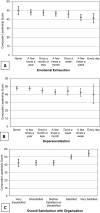Physician Leadership and Its Effect on Physician Burnout and Satisfaction During the COVID-19 Pandemic
- PMID: 40034467
- PMCID: PMC11874771
- DOI: 10.2147/JHL.S487849
Physician Leadership and Its Effect on Physician Burnout and Satisfaction During the COVID-19 Pandemic
Abstract
Purpose: Physician burnout is a global issue associated with low job satisfaction, decreased quality of patient care, reduced productivity, and early retirement from clinical practice. We sought to evaluate the impact of the leadership qualities of direct physician supervisors on the burnout and professional satisfaction of the physicians they supervise.
Methods: An online survey was distributed by Email to all staff physicians practicing at a large Canadian academic tertiary care hospital. The primary outcome was the prevalence of burnout and professional satisfaction, assessed using the 2-item Maslach Burnout Inventory and a single item 5-point Likert scale rating, respectively. The secondary outcome was the relationship between composite leadership score and burnout/satisfaction, with leadership assessed by the 12-item Mayo Clinic Participatory Management Leadership Index.
Results: Out of the 1176 physicians surveyed, 383 (32.6%) responded (51.2% male; 41.5% female). Overall, 41.7% of physicians reported at least one symptom of burnout (40.0% reported high emotional exhaustion; 15.3% reported high depersonalization). 40.1% of physicians reported being satisfied with the organization, 26.3% were neutral, and 33.6% were dissatisfied. On multivariate analysis adjusting for age, sex, duration of employment at the institution, and specialty, each one-point increase in composite leadership score was associated with a 3.1% decrease in the likelihood of burnout (p = 0.0017), and a 6.6% increase in the likelihood of satisfaction (p < 0.0001).
Conclusion: Physician burnout is prevalent and positive leadership qualities of direct supervisors decreases the likelihood of burnout in physicians and increases the likelihood of their satisfaction with the organization.
Trial registration: ClinicalTrials.gov; Identifier: NCT04896307.
Keywords: burnout; leadership; physician wellness; satisfaction.
© 2025 Spilg et al.
Conflict of interest statement
The authors report no conflicts of interest in this work.
Figures



References
-
- Maslach C, Jackson S, Leiter M. Maslach Burnout Inventory Manual.; 1996. Available from: www.mindgarden.com. Accessed February 10, 2025.
-
- Schaufeli W, Leiter M, Maslach C. Burnout: 35 years of research and practice. Career Dev Int. 2009;14(3):204–220. doi:10.1108/13620430910966406 - DOI
Associated data
LinkOut - more resources
Full Text Sources
Medical

